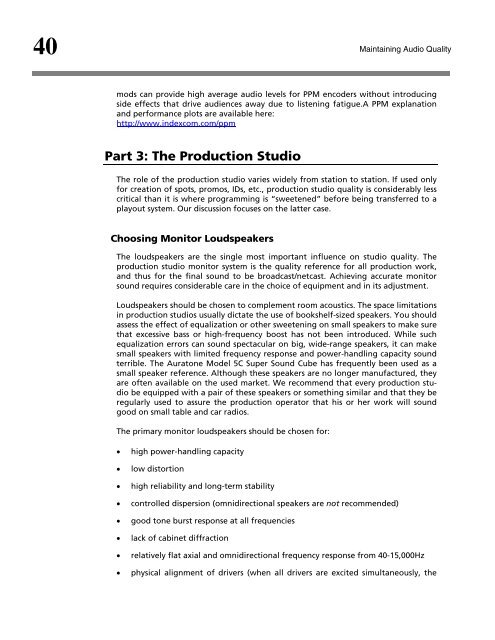Maintaining Audio Quality in the Broadcast Facility 2011 - Orban
Maintaining Audio Quality in the Broadcast Facility 2011 - Orban
Maintaining Audio Quality in the Broadcast Facility 2011 - Orban
Create successful ePaper yourself
Turn your PDF publications into a flip-book with our unique Google optimized e-Paper software.
40<br />
<strong>Ma<strong>in</strong>ta<strong>in</strong><strong>in</strong>g</strong> <strong>Audio</strong> <strong>Quality</strong><br />
mods can provide high average audio levels for PPM encoders without <strong>in</strong>troduc<strong>in</strong>g<br />
side effects that drive audiences away due to listen<strong>in</strong>g fatigue.A PPM explanation<br />
and performance plots are available here:<br />
http://www.<strong>in</strong>dexcom.com/ppm<br />
Part 3: The Production Studio<br />
The role of <strong>the</strong> production studio varies widely from station to station. If used only<br />
for creation of spots, promos, IDs, etc., production studio quality is considerably less<br />
critical than it is where programm<strong>in</strong>g is “sweetened” before be<strong>in</strong>g transferred to a<br />
playout system. Our discussion focuses on <strong>the</strong> latter case.<br />
Choos<strong>in</strong>g Monitor Loudspeakers<br />
The loudspeakers are <strong>the</strong> s<strong>in</strong>gle most important <strong>in</strong>fluence on studio quality. The<br />
production studio monitor system is <strong>the</strong> quality reference for all production work,<br />
and thus for <strong>the</strong> f<strong>in</strong>al sound to be broadcast/netcast. Achiev<strong>in</strong>g accurate monitor<br />
sound requires considerable care <strong>in</strong> <strong>the</strong> choice of equipment and <strong>in</strong> its adjustment.<br />
Loudspeakers should be chosen to complement room acoustics. The space limitations<br />
<strong>in</strong> production studios usually dictate <strong>the</strong> use of bookshelf-sized speakers. You should<br />
assess <strong>the</strong> effect of equalization or o<strong>the</strong>r sweeten<strong>in</strong>g on small speakers to make sure<br />
that excessive bass or high-frequency boost has not been <strong>in</strong>troduced. While such<br />
equalization errors can sound spectacular on big, wide-range speakers, it can make<br />
small speakers with limited frequency response and power-handl<strong>in</strong>g capacity sound<br />
terrible. The Auratone Model 5C Super Sound Cube has frequently been used as a<br />
small speaker reference. Although <strong>the</strong>se speakers are no longer manufactured, <strong>the</strong>y<br />
are often available on <strong>the</strong> used market. We recommend that every production studio<br />
be equipped with a pair of <strong>the</strong>se speakers or someth<strong>in</strong>g similar and that <strong>the</strong>y be<br />
regularly used to assure <strong>the</strong> production operator that his or her work will sound<br />
good on small table and car radios.<br />
The primary monitor loudspeakers should be chosen for:<br />
� high power-handl<strong>in</strong>g capacity<br />
� low distortion<br />
� high reliability and long-term stability<br />
� controlled dispersion (omnidirectional speakers are not recommended)<br />
� good tone burst response at all frequencies<br />
� lack of cab<strong>in</strong>et diffraction<br />
� relatively flat axial and omnidirectional frequency response from 40-15,000Hz<br />
� physical alignment of drivers (when all drivers are excited simultaneously, <strong>the</strong>



![[PDF] Using the ITU BS.1770-2 and CBS Loudness Meters ... - Orban](https://img.yumpu.com/50629372/1/190x245/pdf-using-the-itu-bs1770-2-and-cbs-loudness-meters-orban.jpg?quality=85)






![[PDF] Optimod-FM Feature Comparison - Orban](https://img.yumpu.com/41741615/1/190x245/pdf-optimod-fm-feature-comparison-orban.jpg?quality=85)






